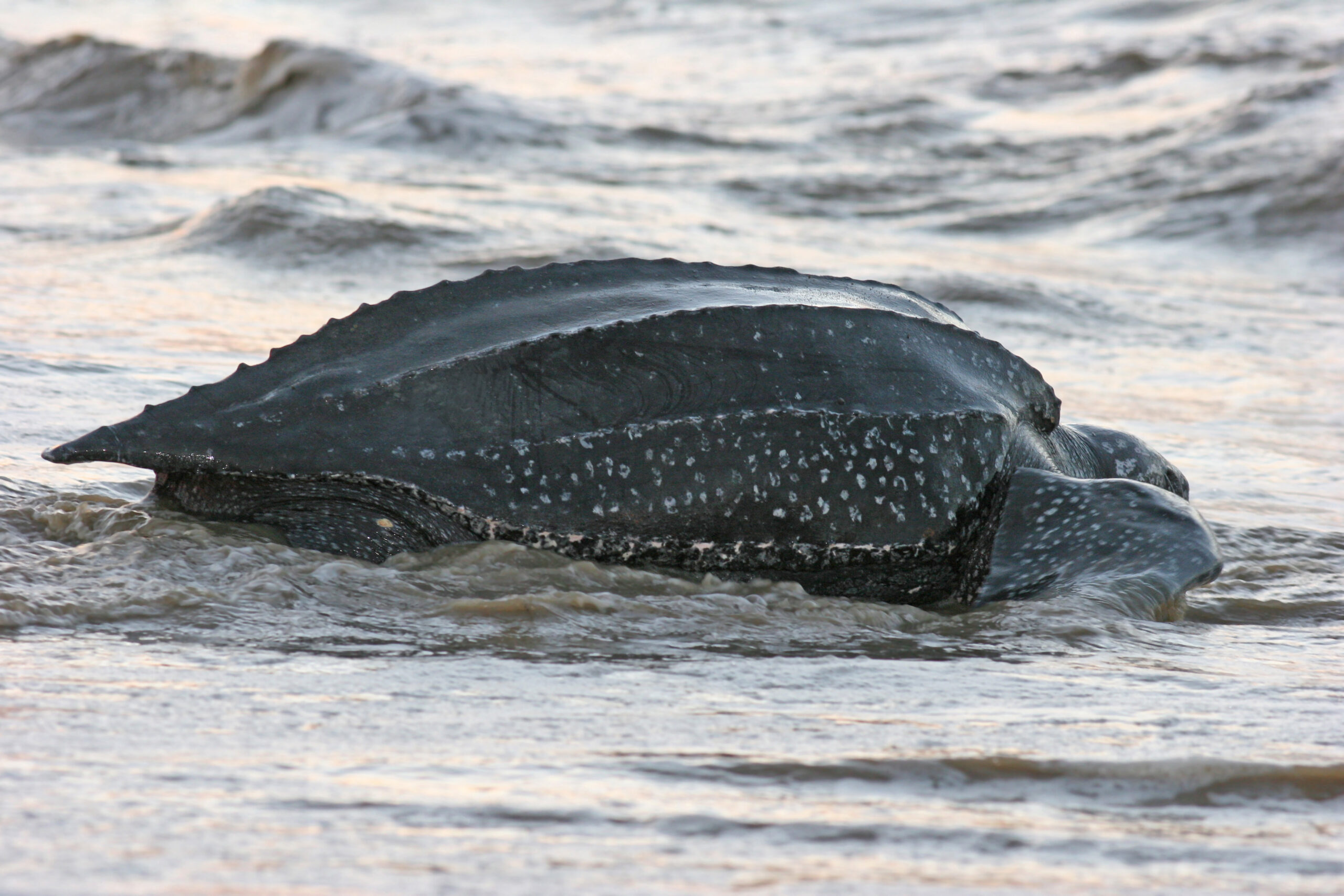The leatherback sea turtle (Dermochelys coriacea) is best described by superlatives. It is the largest of the seven species of sea turtles, weighing up to 2,000 pounds and growing to lengths of up to 8 feet (2). The leatherback can swim almost a mile deep, and has been known to swim over 6,800 miles from nesting beaches to foraging grounds, deeper and further than any other species of sea turtle (2,3).
Because of their large range and nomadic lifestyle, many mysteries still surround leatherback sea turtles.
Life History
There are seven sub-populations of leatherback sea turtles, ranging from as far north as the Arctic Circle and as far south as the southernmost tip of Argentina (1,4). The most significant nesting beach in the United States is on Florida’s Atlantic Coast, where the number of nests can approach 2,000. Beyond the United States, significant nesting beaches exist in Mexico, Costa Rica, Indonesia, Papua New Guinea, West Africa, Solomon Islands, French Guinea, and Gabon (2).
After reaching sexual maturity, females will return every couple of years to the nesting beach where they were born and lay approximately 80 golf ball-sized eggs in a single nesting season (2). In the United States, these visits occur from March to July, with females returning about six times at ten to twelve day intervals (2,3).

Photo Credit: Shutterstock
The eggs hatch after about two months of incubation beneath the sand (2). In the dead of night, hatchlings crawl into the ocean, where they grow about a foot in carapace length each year until they reach juvenile size (1). This growth is facilitated by a diet rich in jellyfish, for which the leatherback’s throat is perfectly adapted. Large, backward-pointing spines beginning in the mouth and travelling down the throat ensure that once a jellyfish is caught, it will be unable to slide back out and escape (2,3).
After about 16 years of eating jellyfish and other soft-bodied prey, leatherbacks reach sexual maturity, and begin the cycle anew. Just as their parents before them, these leatherbacks return to tropical nesting beaches to mate and lay their eggs, and then migrate back to temperate waters to replenish their bodies with more soft-bodied food (2,3).
Threats
Unfortunately, this gentle giant is in decline worldwide (4). Global populations have decreased by 40 percent in the past three generations (3). The Eastern Pacific sub-population has been particularly hard hit, with a 97 percent decline in three generations accompanied with an exponential decline in nesting populations in Mexico and Costa Rica. Mexico, whose beaches once provided nesting habitat for 65 percent of the world’s leatherbacks, has seen a 99 decline in its nesting population since 1980. This precipitous collapse of leatherback populations worldwide has landed this species on the United State’s Endangered Species Act and IUCN’s Red List of Threatened Species (2,3).
The leatherback’s decline has been caused by unsustainable human activities, many of which continue to this day. While it is illegal in the United States, many countries still allow the continued harvest of leatherback eggs and the capture and killing of leatherbacks for their meat (2,3). Humans also impact leatherbacks indirectly. Coastal development has decreased the amount of beach that leatherbacks are able to nest on and increased the use of disorienting beachfront lighting (2,4). Currently, only one out of a thousand hatchlings survive. This is the lowest survival rate of all seven species of sea turtles (1,3).
Human threats to leatherbacks do not end once they reach the ocean. Watercraft strikes, climate change, and pollution will pose threats throughout a turtle’s lifetime (2,4). The leatherback’s foraging habitat is degraded by plastic bags and balloons which, floating in the ocean, closely resemble jellyfish, the leatherback’s favorite food (3).
Leatherbacks are also drowned and killed by commercial fisheries, such as longlines and driftnets. Entangled in fishing line or net, leatherbacks struggle to swim to the surface to breathe. Vast areas of the Pacific Ocean have been closed to longlines and gillnets in order to protect leatherbacks and other marines species but many other areas still remain under siege (2,3)
Visit our Action Center now to learn how you can help Leatherbacks and other marine animals.
Sources
- Conant T, Somma A, Lauritsen AM, & Bibb K (2013) National Marine Fisheries Service 5-Year Review of Leatherback Sea Turtle (U.S., National Marine Fisheries Service, Office of Protected Resources). <https://www.fws.gov/northflorida/seaturtles/Docs/2013_leatherback_sea_turtle_ESA_5-year_status_review_FINAL.pdf>
- North FL Ecological Services Office (2015) Leatherback Sea Turtle (Dermochelys Coriacea). U.S. Fish & Wildlife Service. <https://www.fws.gov/northflorida/seaturtles/turtle%20factsheets/leatherback-sea-turtle.htm>.
- Office of Protected Resources (2016) Leatherback Turtle (Dermochelys Coriacea). NOAA Fisheries. <http://www.nmfs.noaa.gov/pr/species/turtles/leatherback.html>.
- Wallace BP, Tiwari M, & Girondot M (2013) Dermochelys coriacea. The IUCN Red List of Threatened Species 2013: e.T6494A43526147. <http://dx.doi.org/10.2305/IUCN.UK.2013-2.RLTS.T6494A43526147.en>.




